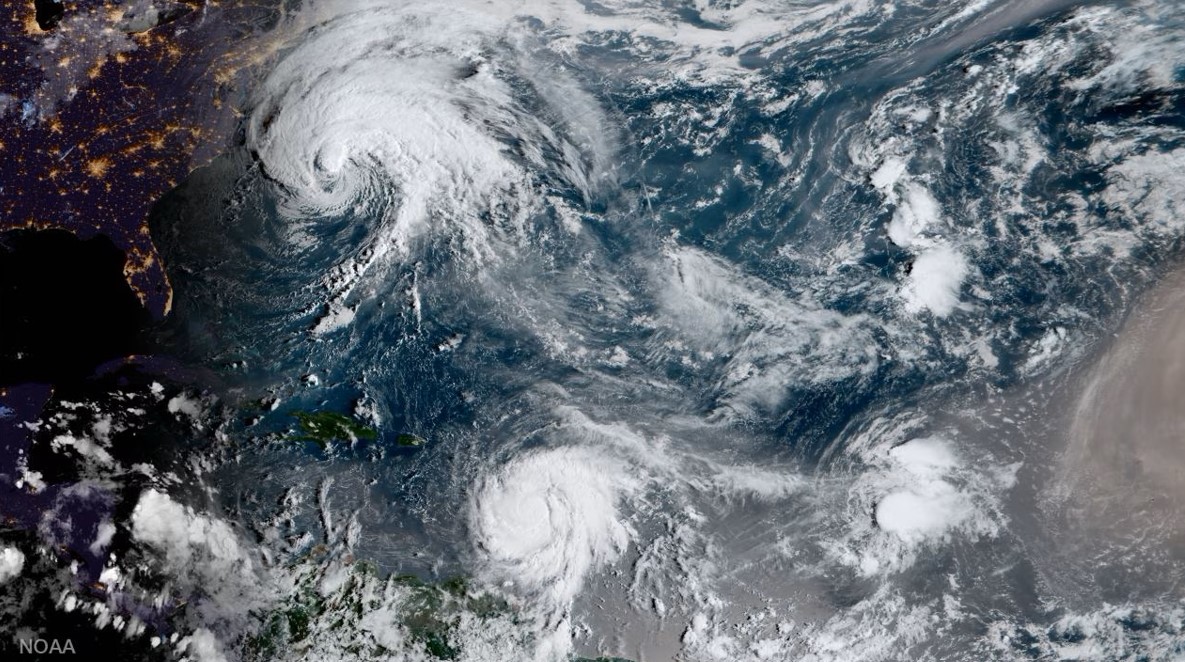The claim: Jet stream manipulation and frequency technology geoengineered Hurricane Lee. A weather forecast map shows a storm off the East Coast in a Sept. 9 Instagram video. “Category 5 Hurricane Lee,” a man says in the video. The East Coast is being targeted by a manmade storm that is building in strength over the Atlantic Ocean. How is this possible? Using jet streams to dam and release. Hurricane Lee’s route can also be checked to see the mainland frequency techs that steer and influence it.” Many experts say geoengineering can’t produce or manipulate hurricanes. Hurricane Lee formed like other hurricanes due to certain atmospheric circumstances.

Project STORMFURY’s goal was to reduce the destructive potential of tropical cyclones by using a technique called cloud seeding, in which aircraft would fly into the storms and disperse silver iodide. (Source: National Weather Service Heritage)
Manmade Technology Can’t Control Hurricanes
On Sept. 7, Hurricane Lee became a Category 5 Atlantic hurricane with 160 mph winds. Hurricane fell to Category 1 on Sept. 12 as it traveled north toward New England and Canada on Sept. 15. Online users are linking the hurricane to geoengineering, a large-scale intervention in Earth’s natural systems to combat climate change, as they have with other natural disasters.
Oxford University describes two types of geoengineering on its website. Solar geoengineering reflects some of the sun’s energy into space to combat temperature rise, whereas carbon geoengineering removes greenhouse gases.
Hurricanes cannot be created through geoengineering. According to Harvard Solar Geoengineering Research Program manager Josh Horton, the most prevalent method of solar geoengineering, stratospheric aerosol injection, could not conceivably be utilized to cause or affect a specific meteorological event like a hurricane.
The procedure “simply doesn’t exist and is not being conducted,” Horton added. Simon Nicholson, co-director of American University’s Institute for Carbon Removal Law and Policy, and Rutgers University climate science professor Alan Robock told USA TODAY there’s no hurricane-controlling technology. Former NOAA Hurricane Research Division head Frank Marks told USA TODAY the agency opposes tropical storm weather modification and geoengineering. “Any claims that any of those types of activities affected Hurricane Lee are false,” Marks emailed. “Man-made influences on Hurricane Lee were likely unintentional and similar to climate change. Hurricane Lee is no different from previous tropical cyclones.”
READ ALSO: Hurricane Lee Could Possibly be Listed as One of the Biggest Hurricanes in New England
Attempt to Modify and Control Hurricanes Failed According to Previous Research
Project Stormfury failed to modify hurricanes in the 1960s by injecting silver iodide into clouds. Program member Hugh Willoughby told USA TODAY there’s no energy-efficient weather control device. “Even a 10-megaton (hydrogen bomb) releases only about as much energy as a thunderstorm cell,” Willoughby emailed. “The H-bomb releases energy in microseconds whereas the thunderstorm takes 30 minutes. Hurricane track shift requires multiple thunderstorms.”
The video’s weather manipulation tactics are also unrealistic, experts say. HAARP program manager Jessica Matthews told USA TODAY that the program’s equipment, which includes high-frequency transmitters, “cannot create or amplify natural disasters.” The troposphere and stratospheric, which produce Earth’s weather, do not absorb HAARP’s radio frequencies, Matthews added. “No interaction means no weather control,” Willoughby told USA TODAY that jet stream modification is conceivable but unlikely. He added the strategy would be “hugely expensive,” like the Cold War or World War II, “and would require 200 years or so to achieve its goals.”
He referred USA TODAY to a NOAA page on tropical cyclone formation. The sea and air must be a certain temperature and moisture, the storm must be far from the equator, and vertical wind shear must be low. According to the NOAA article, Marks said Hurricane Lee was created by an African Easterly Wave, which moves westward at 3 mph from Africa. “About 85% of intense hurricanes and 60% of smaller storms have their origin in African Easterly Waves,” says the website.
READ ALSO: Hurricane Lee Travels Across the Atlantic Ocean Reaching New England Coast

















































